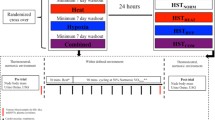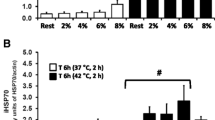Abstract
The purpose of this study was to assess whether a lymphocyte heat shock response and altered heat tolerance to ex vivo heat shock is evident during acclimation. We aimed to use flow cytometry to assess the CD3+CD4+ T lymphocyte cell subset. We further aimed to induce acclimation using moderately stressful daily exercise-heat exposures to achieve acclimation. Eleven healthy males underwent 11 days of heat acclimation. Subjects walked for 90 min (50 ± 8% VO2max) on a treadmill (3.5 mph, 5% grade), in an environmental chamber (33°C, 30–50% relative humidity). Rectal temperature (°C), heart rate (in beats per minute), rating of perceived exertion , thermal ratings, hydration state, and sweat rate were measured during exercise and recovery. On days 1, 4, 7, 10, and 11, peripheral blood mononuclear cells were isolated from pre- and post-exercise blood samples. Intracellular and surface HSP70 (SPA-820PE, Stressgen, Assay Designs), and annexin V (ab14085, Abcam Inc.), as a marker of early apoptosis, were measured on CD3+ and CD4+ (sc-70624, sc-70670, Santa Cruz Biotechnology) gated lymphocytes. On day 10, subjects experienced 28 h of sleep loss. Heat acclimation was verified with decreased post-exercise rectal temperature, heart rate, and increased sweat rate on day 11, versus day 1. Heat acclimation was achieved in the absence of significant changes in intracellular HSP70 mean fluorescence intensity and percent of HSP70+ lymphocytes during acclimation. Furthermore, there was no increased cellular heat tolerance during secondary ex vivo heat shock of the lymphocytes acquired from subjects during acclimation. There was no effect of a mild sleep loss on any variable. We conclude that our protocol successfully induced physiological acclimation without induction of cellular heat shock responses in lymphocytes and that added mild sleep loss is not sufficient to induce a heat shock response.





Similar content being viewed by others
References
Armstrong LE, Maresh CM et al (1994) Urinary indices of hydration status. Int J Sport Nutr 4(3):265–279
Armstrong LE, Epstein Y et al (1996) American College of Sports Medicine position stand. Heat and cold illnesses during distance running. Med Sci Sports and Exerc 28(12):i–x
Armstrong LE, Casa DJ et al (2007) American College of Sports Medicine position stand. Exertional heat illness during training and competition. Med Sci Sports Exerc 39(3):556–572
Asea A (2008) Hsp70: a chaperokine. Novartis Found Symp 291:173–179, discussion 179–183, 221–174
Beckham JT, Wilmink GJ et al (2010) Microarray analysis of cellular thermotolerance. Lasers Surg Med 42(10):752–765
Boreham DR, Dolling JA et al (1997) Heat-induced thermal tolerance and radiation resistance to apoptosis in human lymphocytes. Biochem Cell Biol 75(4):393–397
Borg E, Kaijser L (2006) A comparison between three rating scales for perceived exertion and two different work tests. Scand J Med Sci Sports 16(1):57–69
Born J, Lange T et al (1997) Effects of sleep and circadian rhythm on human circulating immune cells. J Immunol 158(9):4454
Buono MJ, Heaney JH et al (1998) Acclimation to humid heat lowers resting core temperature. Am J Physiol 274(5 Pt 2):R1295–1299
Casa DJ, Armstrong LE et al (2005) Exertional heat stroke in competitive athletes. Curr Sports Med Rep 4(6):309–317
Connolly PH, Caiozzo VJ et al (2004) Effects of exercise on gene expression in human peripheral blood mononuclear cells. J Appl Physiol 97(4):1461–1469
Coris EE, Ramirez AM et al (2004) Heat illness in athletes: the dangerous combination of heat, humidity and exercise. Sports Med 34(1):9–16
Harri M, Kuusela P et al (1982) Temperature responses of rats to treadmill exercise, and the effect of thermoregulatory capacity. Acta Physiol Scand 115(1):79–84
Homburg CH, de Haas M et al (1995) Human neutrophils lose their surface Fc gamma RIII and acquire Annexin V binding sites during apoptosis in vitro. Blood 85(2):532–540
Horowitz M (2001) Heat acclimation: phenotypic plasticity and cues to the underlying molecular mechanisms. J Therm Biol 26:357–363
Horowitz M, Assadi H (2010) Heat acclimation-mediated cross-tolerance in cardioprotection: do HSP70 and HIF-1alpha play a role? Ann N Y Acad Sci 1188:199–206
Horowitz M, Kodesh E (2010) Molecular signals that shape the integrative responses of the heat-acclimated phenotype. Med Sci Sports Exerc 42(12):2164–2172
Horowitz M, Maloyan A et al (1997) HSP 70 kDa dynamics in animals undergoing heat stress superimposed on heat acclimation. Annals of the New York Academy of Sciences 813:617
Jackson AS, Pollock ML et al (1978) Intertester reliability of selected skinfold and circumference measurements and percent fat estimates. Res Q 49(4):546–551
Kuennen MR, Gillum TL et al (2011) Thermotolerance and heat acclimation may share a common mechanism in humans. Am J Physiol Regul Integr Comp Physiol
Liu Y, Lormes W et al (2000) Human skeletal muscle HSP70 response to physical training depends on exercise intensity. Int J Sports Med 21(5):351–355
Liu Y, Lormes W et al (2004) Different skeletal muscle HSP70 responses to high-intensity strength training and low-intensity endurance training. Eur J Appl Physiol 91(2–3):330–335
Machado-Moreira CA, de Castro Magalhães F et al (2005) Effects of heat acclimation on sweating during graded exercise until exhaustion. J Therm Biol 30(6):437–442
Magalhaes Fde C, Amorim FT et al (2010) Heat and exercise acclimation increases intracellular levels of Hsp72 and inhibits exercise-induced increase in intracellular and plasma Hsp72 in humans. Cell Stress Chaperon 15(6):885–895
Maloyan A, Palmon A et al (1999) Heat acclimation increases the basal HSP72 level and alters its production dynamics during heat stress. Am J Physiol 276(5 Pt 2):R1506–1515
Marshall HC, Campbell SA et al (2007) Human physiological and heat shock protein 72 adaptations during the initial phase of humid-heat acclimation. J Therm Biol 32(6):341–348
McClung J, Hasday J et al (2008) Exercise-heat acclimation in humans alters baseline levels and ex vivo heat inducibility of HSP72 and HSP90 in peripheral blood mononuclear cells. Am J Physiol Regul Integr Comp Physiol 294(1):R185
Milne KJ, Noble EG (2002) Exercise-induced elevation of HSP70 is intensity dependent. J Appl Physiol 93(2):561–568
Mora-Rodriguez R, Del Coso J et al (2008) Thermoregulatory responses to constant versus variable-intensity exercise in the heat. Med Sci Sports Exerc 40(11):1945–1952
Moseley PL (1997) Heat shock proteins and heat adaptation of the whole organism. J Appl Physiol 83(5):1413
Moseley PL (1998) Heat shock proteins and the inflammatory response. Ann N Y Acad Sci 856:206
Muldoon S, Bunger R et al (2007) Identification of risk factors for exertional heat illness: a brief commentary on genetic testing. J Sport Rehabil 16(3):222–226
Nelson NG, Collins CL et al (2011) Exertional heat-related injuries treated in emergency departments in the U.S., 1997–2006. Am J Prev Med 40(1):54–60
Nielsen B (1998) Heat acclimation—mechanisms of adaptation to exercise in the heat. Int J Sports Med 19(Suppl 2):S154–156
Nielsen B, Hales JR et al (1993) Human circulatory and thermoregulatory adaptations with heat acclimation and exercise in a hot, dry environment. J Physiol 460:467–485
Nunneley SA, Reardon MJ (2002) Chapter 6 prevention of heat illness. In: Lounsbury DE, Bellamy RF, Zajtchuk R, Pandolf K, Burr R (eds) Medical aspects of harsh environments, volume I. Office of the Surgeon General, United States Army. I, Falls Church
O’Connor FG, Williams AD et al (2007) Guidelines for return to duty (play) after heat illness: a military perspective. J Sport Rehabil 16(3):227–237
O’Connor FG, Casa DJ et al (2010) American College of Sports Medicine Roundtable on exertional heat stroke–return to duty/return to play: conference proceedings. Curr Sports Med Rep 9(5):314–321
Ogura Y, Naito H et al (2008) Elevation of body temperature is an essential factor for exercise-increased extracellular heat shock protein 72 level in rat plasma. Am J Physiol Regul Integr Comp Physiol 294(5):R1600–1607
Oliver S, Costa RJS et al (2009) One night of sleep deprivation decreases treadmill endurance performance. Eur J Appl Physiol 107(2):155
Patterson MJ, Stocks JM et al (2004) Humid heat acclimation does not elicit a preferential sweat redistribution toward the limbs. Am J Physiol Regul Integr Comp Physiol 286(3):R512–518
Ryan AJ, Gisolfi CV et al (1991) Synthesis of 70 K stress protein by human leukocytes: effect of exercise in the heat. J Appl Physiol 70(1):466
Samali A, Holmberg CI et al (1999) Thermotolerance and cell death are distinct cellular responses to stress: dependence on heat shock proteins. FEBS Lett 461(3):306–310
Sandström M, Siegler J et al (2008) The effect of 15 consecutive days of heat-exercise acclimation on heat shock protein 70. Cell Stress Chaperones 13(2):169
Sawka MN, Gonzalez RR et al (1984) Effects of sleep deprivation on thermoregulation during exercise. Am J Physiol 246(1):R72
Sonna L, Gaffin S et al (2002) Effect of acute heat shock on gene expression by human peripheral blood mononuclear cells. J Appl Physiol 92(5):2208
Terao A, Steininger TL et al (2003) Differential increase in the expression of heat shock protein family members during sleep deprivation and during sleep. Neuroscience 116(1):187
Vermes I, Haanen C et al (1995) A novel assay for apoptosis. Flow cytometric detection of phosphatidylserine expression on early apoptotic cells using fluorescein labelled Annexin V. J Immunol Methods 184(1):39–51
Watkins AM, Cheek DJ et al (2008) Heat acclimation and HSP-72 expression in exercising humans. Int J Sports Med 29(4):269
Whitham M, Fortes MB (2008) Heat shock protein 72: release and biological significance during exercise. Front Biosci 13:1328–1339
Whitham M, Laing SJ et al (2007) Effect of exercise with and without a thermal clamp on the plasma heat shock protein 72 response. J Appl Physiol 103(4):1251–1256
Yamada P, Amorim F et al (2007) Effect of heat acclimation on heat shock protein 72 and interleukin-10 in humans. J Appl Physiol 103(4):1196
Yamada P, Amorim F et al (2008) Heat shock protein 72 response to exercise in humans. Sports Med 38(9):715–733
Zhong X, Hilton HJ et al (2005) Increased sympathetic and decreased parasympathetic cardiovascular modulation in normal humans with acute sleep deprivation. J Appl Physiol 98(6):2024–2032
Author information
Authors and Affiliations
Corresponding author
Rights and permissions
About this article
Cite this article
Hom, L.L., Lee, E.CH., Apicella, J.M. et al. Eleven days of moderate exercise and heat exposure induces acclimation without significant HSP70 and apoptosis responses of lymphocytes in college-aged males. Cell Stress and Chaperones 17, 29–39 (2012). https://doi.org/10.1007/s12192-011-0283-5
Received:
Revised:
Accepted:
Published:
Issue Date:
DOI: https://doi.org/10.1007/s12192-011-0283-5




